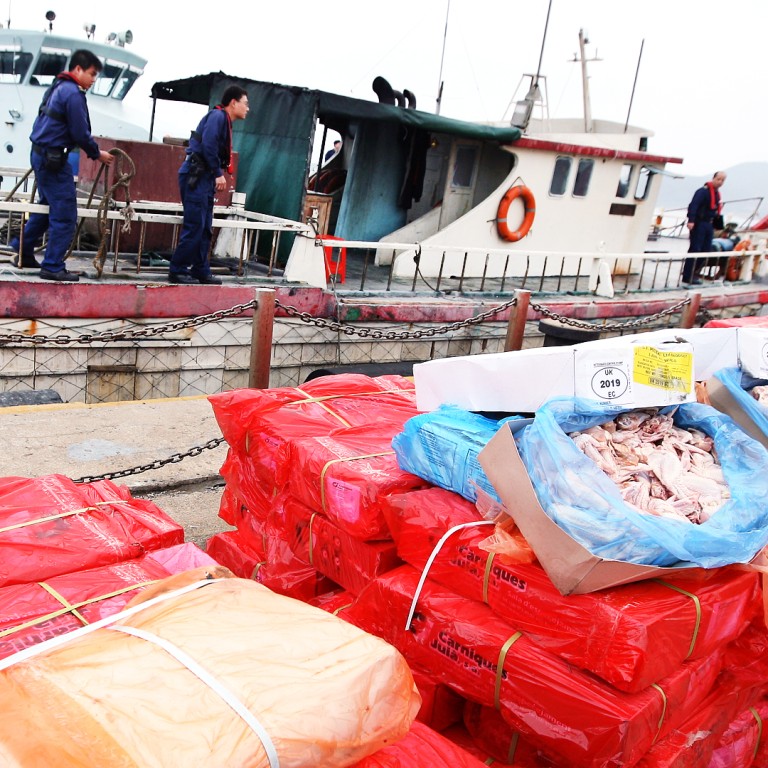
Rotting frozen meat from the 1970s smuggled through Hong Kong into China
Crackdown by mainland customs nets illegally imported frozen products worth 3 billion yuan and identifies the city as a transit point
China's customs has named Hong Kong as a transit point for frozen meat smuggled into the mainland, having netted more than 3 billion yuan (HK$3.8 billion) worth of illegal frozen chicken, beef and pork - some of it up to four decades old.
In the most recent operation, officers in Changsha, Hunan province, found 800 tonnes of smuggled frozen meat worth 10 million yuan - including beef, chicken feet and duck necks - at a local wholesale market on June 1, Xinhua reported.
The meat found in Changsha had been shipped to Hong Kong in containers before being packed together and sent on to Vietnam's northern seaport of Haiphong. The meat was then broken up into smaller consignments at the border city of Mong Cai before being smuggled into China.
After arriving in Changsha, the meat had been destined for dissemination to other parts of China, such as Guangdong, Sichuan and Chongqing, where it would enter restaurants, supermarkets or be sold online.
Xinhua reported that 20 people were arrested during the customs operation in Changsha.
The origin of the frozen meat was not disclosed, but some of it had been stamped with packing dates as far back as the 1970s.
"It was too smelly! [There was] a whole truck of it. I almost threw up when I opened the door," said an officer in the operation.
Some of the meat had already started to thaw and rot when it arrived in Changsha after 12 hours on the road. It was placed in cold storage for refreezing before being sent out again.
According to Hong Kong's Centre of Food Safety, edible products imported for consumption are subject to surveillance, but it does not usually conduct tests on food being exported or re-exported.
The practice was in accordance with international standards, said a government source.
"Since Hong Kong is a popular port for transshipment, it would not be possible for the government to conduct tests on all food that comes through the city. And it would not be fair to use local resources to conduct food tests for other countries too," the source said.
A Hong Kong customs source said there was little it could do if goods were legally imported from overseas and exported from Hong Kong.
But he said customs could tip off agencies at the goods' destination if there were suspicions over the shipment. Hong Kong customs had made various seizures involving frozen meat "from time to time", but all the seizures were of relatively small quantities.
A Customs and Excise Department spokesman said that "based on risk management and intelligence-led principles, Hong Kong customs identifies and selects shipments for inspection at the entry and exit points".
Leung Ka-sing, associate professor of applied biology and chemical technology at Polytechnic University, said the meat might contain large amounts of cancer-causing chemicals to keep it preserved for such long periods, or it might carry bacteria that could cause food poisoning.
Leung said many such preservatives would be tasteless and hard to detect. Such preservatives, many of which could cause cancer when consumed in high volume, would not burn off during the cooking process unless the meat was repeatedly cleaned with boiled water.
The seizure in Changsha was part of a crackdown across 14 provinces by Chinese customs this month. More than 100,000 tonnes of frozen chicken, beef, pork and other meat illegally channelled into the mainland were found, worth more than 3 billion yuan. Twenty-one groups of smugglers were detained.
In 2014, 295,000 tonnes of frozen beef, 562,000 tonnes of frozen pork and 440,000 tonnes of frozen chicken were imported to China, according to mainland customs.
The Huanggang customs in Shenzhen also found parallel traders smuggling frozen meat and seafood into the mainland at Futian port during a crackdown in January.
The role of Hong Kong's food safety watchdog
In Hong Kong, the Centre for Food Safety conducts tests on various produce, including both fresh and frozen meat. But it is understood that the centre usually does not conduct tests on food that is earmarked for export or re-export.
According to the centre, food safety inspectors take samples for testing at various levels of the supply chain, adopting the World Health Organisation's "from farm to table" food safety strategy. It also adopts a risk-based principle in determining the types of samples to be collected, the frequency and number of samples taken and the types of analysis to be conducted. The tests cover major food groups such as fruits and vegetables, meat, poultry, aquatic products, milk and cereals.
The centre said it conducted tests on about 64,100 food samples last year - about nine samples per 1,000 people in Hong Kong.
Lawmaker Helena Wong Pik-wan, though, said it may be difficult for health officials to trace online orders mailed into the city, a loophole that has yet to be plugged.
Wong and other lawmakers have demanded the centre increase the number of samples it tests, while the centre said it had a relatively high testing rate compared to overseas jurisdictions.
Last year, there were 139 unsatisfactory samples found among tested items, resulting in an overall satisfaction rate of 99.8 per cent.


